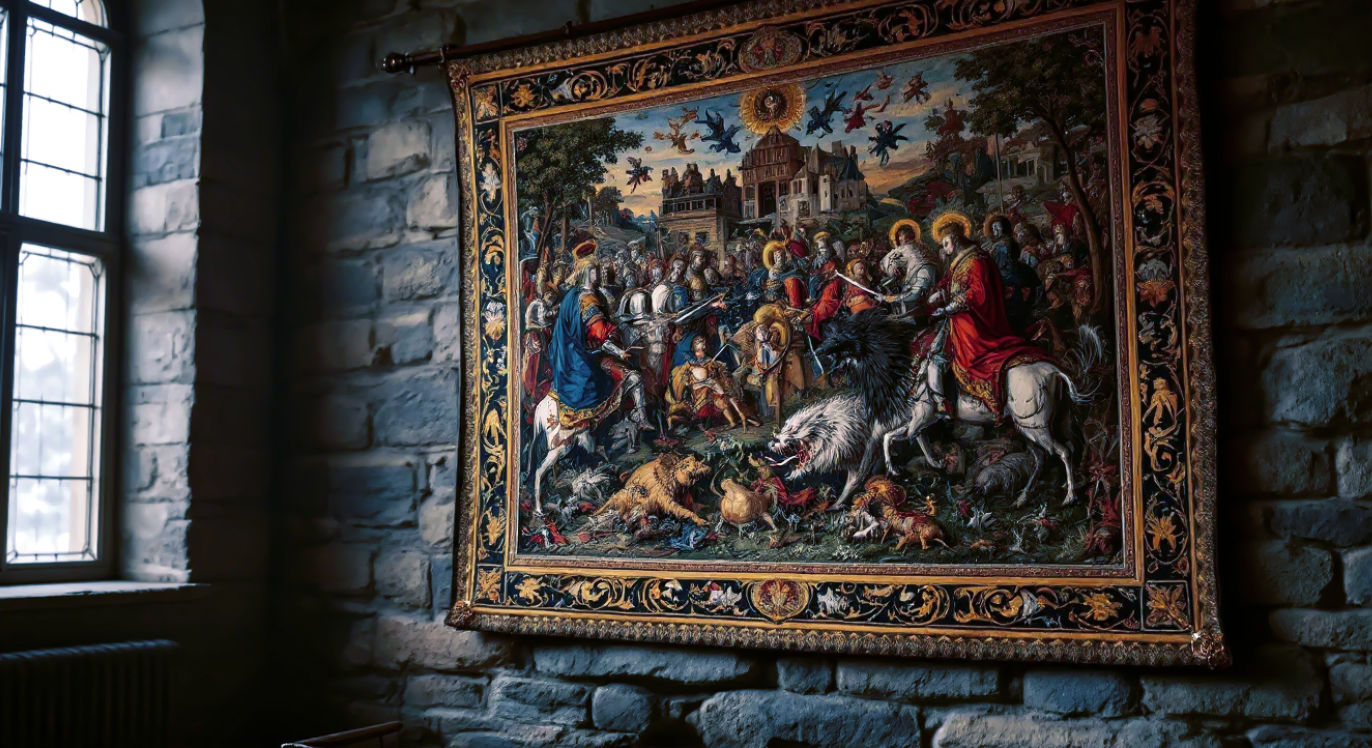Woven Worlds: The Guide to Decorative Tapestries
Explore the ultimate guide to decorative tapestries. Uncover their history, the art of weaving, and practical tips for bringing this timeless art into your own home.

This post may contain affiliate links. If you make a purchase through these links, we may earn a commission at no additional cost to you.
You’ve almost certainly seen one. Perhaps it was in a grand National Trust property, a cavernous, slightly chilly castle, or even a cosy pub named ‘The King’s Head’. It was probably huge, hanging on a stone wall, depicting knights, ladies, or a bewildering number of trees. You might have glanced at it, thought, “That’s old,” and moved on. But what if that wall hanging was more than just a dusty decoration? What if it was a storybook, a radiator, a status symbol, and a masterpiece of art all rolled into one?
Welcome to the world of decorative tapestries. They are far more than just old-fashioned pictures made of cloth. They are woven chronicles of history, power, and human creativity. For centuries, they were the ultimate luxury item, more valuable than paintings, telling stories to a world that mostly couldn’t read. And today, they’re making a surprising comeback, bringing texture, warmth, and a touch of grand history into modern British homes.
This guide will unravel the story of the tapestry. We’ll explore what they actually are (and what they’re not—we’re looking at you, Bayeux Tapestry), how they’re made, and why they were the medieval equivalent of a blockbuster film. We’ll then bring the story home, looking at Britain’s own unique contribution to the art and giving you practical advice on how to choose, hang, and care for one yourself. So, pull up a chair; the story is about to begin.
What Exactly Is a Tapestry? Weaving vs. Sewing
Before we go any further, we need to clear something up. It’s one of the biggest mix-ups in the art world, and it involves Britain’s most famous textile treasure.
Most people think a tapestry is any picture made with thread on cloth. But that’s not quite right. A true tapestry is a piece of textile art that is woven on a loom.
Think about it like this: weaving involves creating the fabric and the image at the exact same time. It’s done with two sets of threads.
- The warp threads are the strong, plain threads stretched vertically up and down the loom. They form the backbone of the fabric but are completely hidden in the final piece.
- The weft threads are the colourful threads that are woven horizontally, back and forth, over and under the warp threads. These are the threads you see, the ones that create the picture.
The weaver works from a design, called a cartoon, placed behind or under the warp threads. They pack the colourful weft threads down so tightly that the plain warp threads are completely covered. This technique is called weft-faced weaving, and it’s what defines a true tapestry. It’s like painting with thread, but instead of putting colour on top of a canvas, you’re building the canvas and the colour at the same time. The image is literally the structure of the fabric itself.
The Great British Mix-Up: The Bayeux Tapestry
Now, what about the Bayeux Tapestry? This incredible 70-metre-long masterpiece tells the story of the Norman Conquest of England in 1066. It’s a national treasure, a priceless piece of history, and… it’s not actually a tapestry.
The Bayeux Tapestry is technically an embroidery. The images are not woven into the fabric. Instead, a team of embroiderers took a long piece of plain linen cloth and stitched the pictures onto it using coloured wool threads. The background cloth is still visible. So, while we all call it a tapestry, and will continue to do so, it’s important to know the difference. It’s like calling a sculpture a painting because they both show a person. Both are amazing art forms, but they’re made in fundamentally different ways.
A Woven History: From Ancient Tombs to Stately Homes
The story of tapestry is a long one, stretching back thousands of years. While fragile threads don’t survive the centuries well, we have found pieces in ancient Egyptian tombs and read descriptions in Greek poems. But the golden age of the tapestry really began in medieval Europe.
The Medieval Must-Have: Warmth, Wealth, and Storytelling
In the Middle Ages, if you were a king, a duke, or a bishop, you needed tapestries. Your castle or palace was likely made of stone, which made it grand but also draughty, damp, and freezing cold in winter. Tapestries were a brilliant solution. Hung on the walls, these thick woollen hangings acted as fantastic insulators, trapping heat and making rooms far more comfortable.
But they were so much more than posh insulation.
- They were a symbol of immense wealth and power. Creating a tapestry was an incredibly slow and expensive process. A team of skilled weavers might only complete a square metre in a month. The materials—wool, silk, and sometimes even threads wrapped in real gold or silver—were costly. Owning a set of tapestries was like owning a fleet of supercars today. It screamed, “I am rich and important.”
- They were portable palaces. Nobles and kings didn’t stay in one place; they moved between their various castles and estates. They would roll up their precious tapestries and take them with them. When they arrived at their next stop, they would unroll and hang the tapestries, instantly transforming a cold stone fortress into a luxurious and familiar home.
- They were the television of their time. In a world where most people couldn’t read, tapestries told the stories that mattered. They showed scenes from the Bible, tales of Greek and Roman gods, famous battles, and romantic legends of chivalry. They were packed with detail and symbolism, and people could spend hours ‘reading’ the stories woven into the threads.
The great centres of tapestry production in the 14th and 15th centuries were in Paris and Arras (in modern-day France). The quality was so high that in Britain, the word “arras” became a generic term for any tapestry, which is why Shakespeare has Hamlet hide behind an “arras” to spy on his mother.
The Renaissance: Bigger, Bolder, and More Artistic
By the 16th century, the centre of the tapestry world had moved to what is now Belgium, particularly the cities of Brussels and Bruges. The designs became even more complex and artistic. Famous painters like Raphael, the great Italian Renaissance artist, were hired to create the cartoons.
Tapestries became enormous, coordinated sets designed to cover every wall of a great hall. The subjects were still grand—mythology, history, religion—but the style was new. They were filled with muscular heroes, dramatic scenes, and incredibly detailed borders overflowing with flowers, fruits, and animals. These were the ultimate statement pieces, commissioned by powerful rulers like King Henry VIII, who was an avid collector and owned over 2,000 tapestries.
Britain Joins the Weave: Mortlake and William Morris
For centuries, England had mostly imported its finest tapestries from the continent. But in the 17th century, that began to change. King James I, wanting to keep money in the country and create luxury goods at home, set up the Mortlake Manufactory on the banks of the River Thames near London in 1619.
He brought over 50 expert weavers from Flanders and set them to work. Mortlake quickly became famous for its incredible quality, producing stunning tapestries for the Royal Family and wealthy aristocrats. For a time, it was the most important workshop in Europe. Sadly, the English Civil War disrupted its business, and it eventually closed in 1704.
The art of tapestry fell out of fashion for a while, seen as a bit old-fashioned compared to painting and wallpaper. But it was revived in spectacular fashion in the late 19th century by one of Britain’s most famous designers: William Morris.
Morris was the leading figure in the Arts and Crafts Movement, which rejected cheap, mass-produced factory goods. He believed in the beauty of handmade items and traditional skills. He hated what he saw as the ugliness of the industrial world and wanted to bring art back into people’s homes.
He taught himself how to weave and set up looms at his workshop at Merton Abbey. Morris & Co. produced tapestries that were completely different from the grand historical scenes of the past. Inspired by medieval designs, his tapestries focused on the beauty of nature. They were filled with swirling leaves, dense trees, charming birds, and animals, often with figures from myth and legend. His most famous designs, like The Woodpecker, are beloved for their rich detail and sense of romance. William Morris made tapestry art relevant to the modern home and inspired a whole new generation of artist-weavers.
Tapestry in the 20th and 21st Centuries
The art of tapestry weaving has continued to evolve. In the 20th century, famous modern artists like Pablo Picasso and Henry Moore had their designs turned into tapestries. The art form was no longer just about copying paintings; it became a medium for bold, abstract expression.
Today, tapestry is thriving. Artists are pushing the boundaries of what’s possible. Some use traditional techniques to create stunning contemporary art. A brilliant British example is Grayson Perry, whose series of six large-scale tapestries, The Vanity of Small Differences, tells a story of modern British life and class with incredible wit and detail. They are as much a social commentary as the historical tapestries of the past.
Other artists are using new technology. Digital Jacquard looms can translate complex computer designs into woven fabric, blending ancient craft with modern innovation. Meanwhile, in homes across Britain, people are rediscovering the appeal of textile art. A wall hanging can bring colour, texture, and a unique personality to a room in a way a framed print simply can’t.
How a Tapestry Is Made: From Sketch to Fabric
Understanding how a tapestry is made really makes you appreciate the skill and patience involved. It’s a slow, deliberate process that hasn’t changed all that much in hundreds of years.
Step 1: The Design (The ‘Cartoon’)
Everything starts with the design. This is a full-size, full-colour drawing or painting of what the final tapestry will look like. It’s called a cartoon. In the past, a famous artist would be paid a huge sum to create the cartoon, and then a team of weavers would be responsible for translating it into thread.
Step 2: Setting Up the Loom
Next, the loom is prepared. A loom is essentially a big, strong frame for holding the threads under tension. There are two main types:
- Low-warp loom: The loom is horizontal, like a table. The weaver sits and looks down at the threads. The cartoon is placed underneath the warp threads, so the weaver can see it directly. This method is faster.
- High-warp loom: The loom is vertical, standing upright. The weaver sits in front of it. The cartoon is placed behind the weaver, who has to look at its reflection in a mirror placed behind the loom. This method is slower but many believe it allows for more artistic detail.
The plain warp threads are then stretched tightly across the loom. This is the blank canvas.
Step 3: The Weaving
Now for the magic. The weaver takes a bobbin—a small spool—wound with a specific colour of weft thread. Following the cartoon, they pass the bobbin over and under the warp threads, but only in the small section where that particular colour is needed.
If they’re weaving a leaf, they might use several shades of green. They don’t pass the green thread all the way from one side of the tapestry to the other. They just weave it back and forth in the shape of the leaf. Then they pick up a bobbin of blue for the sky next to it, and a bobbin of brown for the branch. This is why tapestry weaving is so slow. The weaver is building the image patch by patch, colour by colour.
As they work, they use a heavy comb-like tool to pack the weft threads down tightly, making sure the warp threads are completely covered. This creates a dense, durable fabric. One of the tell-tale signs of a hand-woven tapestry is the small vertical slits that can appear where two blocks of colour meet. Weavers often have clever tricks to stitch these up or avoid them.
Because the image is built from the bottom up, the weavers are often working on a small section without seeing the whole picture clearly. And on a high-warp loom, they are working from the back, so they can only see what they’ve done by using a mirror. It requires incredible skill and concentration.
Step 4: The Finishing Touches
Once the weaving is finally complete—a process that could take months or even years—it is cut from the loom. The loose ends are tidied up, and it might be lined with a backing cloth to help it hang properly. The masterpiece is finally ready.
Tapestries in Your Home: A Practical Guide
You don’t need to own a castle to enjoy the beauty of a tapestry. A well-chosen wall hanging can be a stunning focal point in any home, from a modern flat to a country cottage. It adds warmth, texture, sound absorption, and a story that no other wall decoration can.
Choosing the Right Tapestry
First, think about style. Do you want something that looks like a traditional, historic piece, or something modern and abstract?
- Antique & Reproduction: These tapestries often feature classic scenes—landscapes (called verdure, from the French for ‘greenery’), mythical tales, or floral patterns. They bring a sense of history and grandeur to a room and work beautifully in traditional or eclectic interiors. You can buy genuine antiques, but good-quality reproductions made in Belgium or France offer the same look for a fraction of the price.
- Modern & Contemporary: Many modern artists create tapestries. These can range from bold geometric designs to abstract colour fields or even quirky, narrative pieces. A modern tapestry can be a fantastic way to add a major splash of colour and personality to a minimalist or contemporary room.
- Jacquard Woven vs. Hand-Woven: A hand-woven tapestry is a unique piece of art and will have a price tag to match. Most affordable tapestries today are woven on a Jacquard loom, a mechanical loom that can create complex patterns. The quality can be excellent, and they make the art of tapestry accessible to many more people.
Next, consider size and placement. A huge tapestry in a tiny room will feel overwhelming. A tiny tapestry on a huge wall will look lost. Measure your wall space carefully. A large tapestry can be the main feature in a living room or hung behind a bed as a dramatic headboard. Smaller pieces can work well in hallways, alcoves, or above a fireplace.
How to Hang Your Tapestry
Hanging a tapestry correctly is important for its appearance and its long-term health. The aim is to distribute its weight evenly.
- Create a Casing: The best method is to have a professional stitch a strong pocket or sleeve of fabric (called a casing) along the top edge on the back of the tapestry.
- Use a Rod: You can then slide a wooden batten or a metal curtain rod through this casing.
- Attach Brackets: Fix two or more brackets to the wall, making sure they are level. Place the rod onto the brackets. This ensures the weight is spread evenly across the top of the tapestry, preventing it from sagging or stretching out of shape over time.
For very heavy or valuable antique tapestries, it’s best to consult a professional textile conservator. They might recommend using a Velcro system, where one strip is stitched to the tapestry and the other is fixed to a wooden batten on the wall. Never hang a tapestry by nailing the corners directly to the wall, as this will cause damage.
Caring for Your Tapestry
Textiles are more vulnerable than paintings, but with a little care, your tapestry will last for generations. The two biggest enemies are dust and sunlight.
- Dusting: Every few months, you can gently vacuum the tapestry to remove dust. Use the lowest suction setting on your vacuum cleaner and place a piece of nylon mesh (like an old pair of tights) over the nozzle to prevent snagging the threads. Gently touch the nozzle to the surface; don’t rub it.
- Sunlight: Direct sunlight will cause the beautiful colours to fade over time. Try to hang your tapestry on a wall that doesn’t get strong, direct sunlight. If this is unavoidable, consider using UV-filtering film on your windows or closing the curtains during the brightest part of the day.
- Cleaning: Never try to wash a tapestry in a washing machine or get it dry-cleaned. If it needs a serious clean, you must take it to a specialist textile conservator. They have the knowledge and equipment to clean it safely.
- Damp: Avoid hanging tapestries on damp walls, as this can lead to mould and mildew.
The Enduring Appeal of Woven Worlds
From the draughty walls of a medieval castle to the chic living room of a modern London flat, the tapestry has woven its way through our history and our homes. It’s an art form that connects us to the past—to the patient hands of the weavers, the grand ambitions of kings, and the timeless stories that define our culture.
They are at once both art and craft, story and decoration, grand and intimate. They remind us that beauty can be found in slow, deliberate work and that a simple thread can be used to build a whole world. Whether you’re admiring one in a museum or choosing one for your own wall, you’re taking part in a story that’s been centuries in the making.
Further Reading
For those interested in exploring further, here are some highly respected resources:
- The Victoria and Albert Museum (V&A): The V&A in London has one of the world’s most important tapestry collections. Their website is a treasure trove of information.
- The National Trust: Many National Trust properties throughout the UK house significant collections of historic tapestries in their original settings.
- The Burrell Collection: This Glasgow museum is renowned for its exceptional collection of late-gothic and early-renaissance tapestries.
- West Dean College of Arts and Conservation: A leading centre for studying textile conservation and tapestry weaving.






